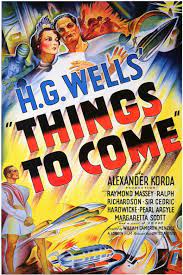
In 1940, businessman John Cabal (Raymond Massey), who lives in Everytown, England, is worried at Christmas because of rumors of war. His guest Harding (Maurice Braddell) is worried as well, but the over-optimistic Pippa Passworthy (Edward Chapman) does not believe war will come. But if it does, it will accelerate technological progress. That night, the enemy bombs the city and global war begins.
Months later, Cabal is an airman in the Royal Air Force and pilots a Hawker Fury. He shoots down an enemy aircraft, then lands and pulls the enemy pilot (John Clements) from the wreck. They put on their gas masks, a young girl appears, and the enemy pilot gives up his mask to her. Cabal gives the man his revolver and takes the girl away in his plane. The enemy pilot, before shooting himself, muses on the fact that he may have gassed her family but, meeting her, dies for her. The war continues to the 1960s, when the world no longer knows why it is fighting. It is a dark age, the world in ruins, the economy destroyed, and no technology left that is not for war. By 1966, a biological weapon is deployed, and the Wandering Sickness begins. The plague destroys half the people and all of the governments.
By 1970, the warlord Rudolf (Ralph Richardson), also called the Boss, is chieftain of Everytown and has shot all the infected people. He starts another war, against the Hill People, for coal and shale to produce fuel for his ancient airplanes. On May Day, a sleek new plane lands in Everytown. The pilot, John Cabal, emerges and speaks of the last surviving mechanics and engineers creating “Wings Over the World”, based in Basra, Iraq. They have outlawed war and are reviving civilization. He offers the Boss and his brigands membership. The Boss arrests him, forcing him to work for his mechanic Gordon (Derrick De Marney), who is trying to keep the old planes flying. Gordon takes a plane and heads for Wings Over the World.
Gigantic flying wings arrive over Everytown and drop sleeping gas. The Boss’s old planes are useless. Everyone awakes to find themselves under new control and the Boss is dead. A montage shows decades of progress and by 2036 mankind is living in modern underground cities in peace, but the sculptor Thetocopulos (Sir Cedric Hardwicke) demands an end to progress, symbolized by the coming flight around the moon. The Luddites are opposed to Oswald Cabal (Raymond Massey again), grandson of John Cabal. His daughter Catherine (Pearl Argyle) and Maurice Passworthy (Kenneth Villiers) want to crew the capsule. A mob rushes the space gun and Cabal launches it early. When the projectile is just a tiny light in the sky, Cabal gives a philosophical monologue about what is coming--progress and mankind’s quest for knowledge as we head out into space.
This was a 1936 British black and white film directed by William Cameron Menzies, produced by Alexander Korda, and written by H.G. Wells, based on his 1933 book The Shape of Things to Come. His name appears in large print everywhere the movie is mentioned, but he had no particular control over the film. Apparently, he directed for a while at the beginning, but the job was quickly turned over to Menzies. Wells was determined to create an alternate future to that of the film Metropolis, which he hated, calling it silly, cliché-ridden, and muddled. Menzies proceeded quietly to be influenced by Metropolis anyway. The art design was by Vincent Korda, the producer’s brother. The visuals are imaginative and impressive, but the story somewhat improbable and seriously didactic. Arthur C. Clarke had Kubrick watch it before beginning 2001: A Space Odyssey, but Kubrick disliked it.
The film was criticized in the US for not addressing class struggle and in the UK for its supposed socialist political beliefs. It drew huge crowds at first, but they tapered off quickly. People laughed at the beginning, in which warplanes attacked England, but World War II happened pretty much like it did in the movie. The depiction of war was powerful and disturbing. Details like personal transport devices, huge tunneling machines, vast automated factories, flat screens and jumbotrons all appeared in reality within 80 years. The space gun, however, would have killed anyone who used it. Some of the sets are mind-blowing and the airplanes, if a little strange, are gorgeous. The somewhat laughable costumes are based on the kata-ginu of Samurai warriors, with the huge shoulders. Just about every science-fiction movie since has been dripping with the visual influence of both Metropolis and Things to Come.
